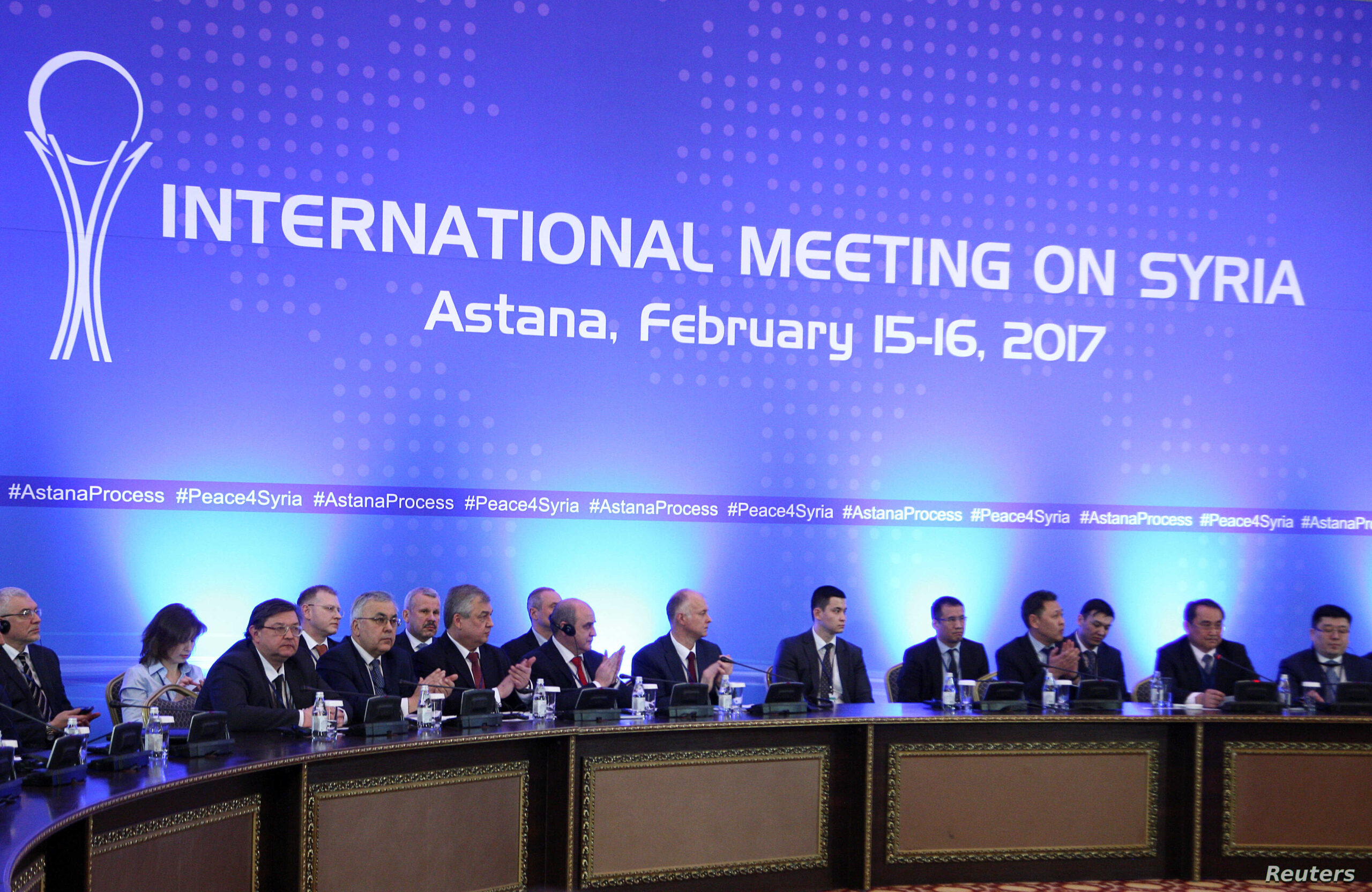
Participants of Syria peace talks attend a meeting in Astana, Kazakhstan February 16, 2017. REUTERS/Mukhtor Kholdorbekov – RTSYZEI
On January 23, the next phase of peace talks started in the capital of Kazakhstan, Astana. Syria’s government and opposition forces are to meet in Kazakh capital Astana for the first time since the fall of Aleppo. Negotiations between the Syrian government delegation and rebel fighters, sponsored by Russia and Turkey – who have been backing different sides of the conflict – are expected to last three days.
One of the most significant points of the talks is that this time Syrian opposition is represented mainly by the militant groups, which fight in Syria, not just by secular, and political forces. Nevertheless, uncertainty prevails over all aspects of the talks – from the attendant list to the agenda of the meeting. The guarantors of the Astana talks – Turkey, Iran, and Russia are seemingly making efforts to show the effectiveness of the “Troika” format over Syrian talks. The governments of Russia, Turkey, and Iran are set to send officials from their ministers of defense and foreign affairs. The ministers are not expected to attend what is expected to be an essentially technocratic gathering.
Considering the comments and opinions of various experts, it is safe to note that the talks are supposed to be an important step in the way of shifting the balance of power in the Syrian crisis. The format of “Troika” is supposed to replace Moscow – Washington led Syria dialogue, as it has not justified itself showing less capability to affect so-called allies on the “ground”.
Therefore, all previous efforts of Moscow and Washington to halt the escalation of the crisis were unsuccessful due to the provocation of the Syrian regime, or rebellion groups along the line of contact (LoC). Eventually, after the peace talks in Lausanne in September of 2016 ended without any significant progress, Russia – US dialogue over Syria completely fell apart.
“Troika format”
Thus, the new “Troika format” had appeared as an alternative to US-Russia mediation. Although the members of Troika seek to enhance the coordination between Assad’s regime and opposition forces in order to avoid a new military escalation, Iran seems to be mostly interested in consolidating Shiite forces in Syria amid talks in Astana.
Regardless of the common priority of the Troika, the Shiite factor that actively promotes by Iran revealed the huge divergences mainly between Ankara and Tehran. Meanwhile, Ankara urged Tehran to withdraw Shiite militants in Syria as part of efforts to usher in a truce in the war-torn country.
In fact, the rising influence of Iran-backed Hezbollah in Syria causes huge concerns in Ankara and threatens the faith of the peace negotiations in Astana. The Syrian opposition says the government and Iranian-backed militias are continuing military offensives in several areas in Syria, including in Wadi Barada, near Damascus, regardless of the ceasefire.
However, the opposition factions have few cards at their disposal and may have to choose between agreeing to separate from terrorist groups, such as the al-Qaeda-linked Jabhat Fateh al-Sham (JFS) – formerly the Nusra Front – or face their destruction.
The neutral platform
Apparently, Astana talks could be seen as a new phenomenon in the history of Syrian talks, as a new “neutral platform” of peace negotiations make it possible to quit the “Geneva platform” – also neutral but de-facto led by the West. The new tendency in the peace process allowed to dislocate the center of negotiations directly to the East, which is very suitable for the members of Troika.
The absence of the US, Kurdish YPD/PYG, and the EU in Astana talks make Russia, Iran, and Turkey feel more comfortable, as they believe that countries directly involved in the conflict would reach the tortured consensus. However, on the second day of the talks, any significant deal has not been reached yet.
Most probably the conflicting parties, in particular, opposition forces under the pressure of international players, will reach an agreement on certain issues, such as the extension of the ceasefire agreement and evacuation of civilians from battle zones. But the question of how long will the ceasefire agreement among conflicting parties in Syria last remains unanswered.
Moreover, the contradictions among “Troika” member countries, especially tough relations between Ankara and Tehran accompanied with mutual mistrust make the negotiations in Astana nearly impossible.
Iran and Turkey – traditional geopolitical foes in the Middle East are keen to maintain strong positions in the region. In this regard, both regional players do not hide their concern over the growing influence of Russia in Syria.
To sum up, the ongoing talks in Astana may lead to further peace negotiations between Assad’s regime and military opposition forces, but the current talks will definitely pursue a long-awaited resolution of the conflict.
If “Troika” aims to settle down the conflict, the format of Astana talks must include not only regional but also international players. Given the current status of the Syrian conflict, it would be really hard for the “Troika” to halt the bloodshed in another part of Syria without the assistance of international players.
Thus, the Astana talks could be succeeded when it turns to an international platform within the participation of main countries – the US, Gulf countries, Jordan, and so on.
Disclaimer: Views expressed by writers in this section are their own and do not reflect Al Arabiya English’s point-of-view.
